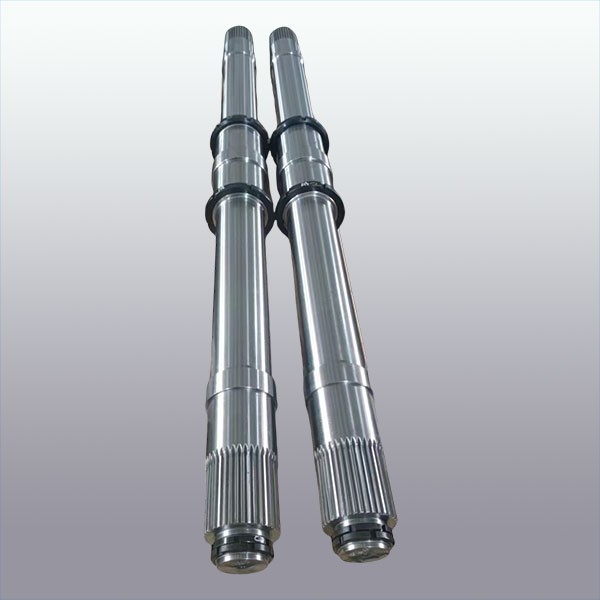As a supplier of anchor hinge shafts, I've seen my fair share of damaged parts over the years. It's crucial for boat owners, maintenance crews, and anyone involved in the marine industry to recognize the signs of a damaged anchor hinge shaft. This not only ensures the safety of the vessel but also prevents further costly damage down the line. In this blog post, I'll walk you through the common signs that your anchor hinge shaft might be in trouble.
1. Visible Wear and Tear
One of the most obvious signs of a damaged anchor hinge shaft is visible wear and tear. Look for scratches, dents, or corrosion on the surface of the shaft. These can be caused by a variety of factors, including regular use, exposure to saltwater, and improper maintenance.
Scratches and dents can weaken the shaft over time, making it more susceptible to breakage. Corrosion, on the other hand, can eat away at the metal, reducing its strength and integrity. If you notice any of these signs, it's important to inspect the shaft closely and consider replacing it if necessary.
2. Excessive Vibration
Another telltale sign of a damaged anchor hinge shaft is excessive vibration. When the shaft is damaged, it can cause the anchor to vibrate abnormally while it's being raised or lowered. This vibration can be felt throughout the boat and can even be heard as a rattling or humming noise.
Excessive vibration can be caused by a number of factors, including misalignment, imbalance, or damage to the shaft itself. If you experience excessive vibration, it's important to stop using the anchor immediately and have the shaft inspected by a professional. Continuing to use a damaged shaft can lead to further damage and potentially dangerous situations.
3. Difficulty Raising or Lowering the Anchor
If you're having difficulty raising or lowering the anchor, it could be a sign of a damaged anchor hinge shaft. A damaged shaft can cause the anchor to bind or stick, making it difficult to operate. This can be especially dangerous in rough weather or when you need to anchor quickly.
Difficulty raising or lowering the anchor can also be caused by other factors, such as a clogged anchor chain or a malfunctioning windlass. However, if you've ruled out these possibilities and still experience problems, it's likely that the shaft is damaged.


4. Unusual Noises
In addition to excessive vibration, a damaged anchor hinge shaft can also produce unusual noises. These noises can include grinding, squeaking, or clicking sounds. These noises are often a sign of friction or wear between the shaft and other components of the anchor system.
Unusual noises can also be caused by other factors, such as loose or worn bearings. However, if you hear these noises while operating the anchor, it's important to have the shaft inspected as soon as possible. Ignoring these noises can lead to further damage and potentially costly repairs.
5. Misalignment
Misalignment is another common sign of a damaged anchor hinge shaft. When the shaft is misaligned, it can cause the anchor to sit at an angle or not line up properly with the anchor locker. This can make it difficult to stow the anchor safely and can also cause damage to the boat.
Misalignment can be caused by a number of factors, including improper installation, damage to the shaft or other components, or normal wear and tear. If you notice that the anchor is not sitting properly or is causing damage to the boat, it's important to have the shaft inspected and realigned if necessary.
6. Reduced Performance
Finally, a damaged anchor hinge shaft can also lead to reduced performance. When the shaft is damaged, it can cause the anchor to lose its holding power or not set properly. This can be especially dangerous in rough weather or when you need to anchor in a strong current.
Reduced performance can also be caused by other factors, such as a worn or damaged anchor. However, if you've ruled out these possibilities and still experience problems, it's likely that the shaft is damaged.
Conclusion
Recognizing the signs of a damaged anchor hinge shaft is crucial for maintaining the safety and performance of your boat. If you notice any of the signs mentioned above, it's important to have the shaft inspected by a professional as soon as possible. Ignoring these signs can lead to further damage and potentially dangerous situations.
At our company, we offer a wide range of high-quality anchor hinge shafts that are designed to meet the needs of boat owners and marine professionals. Our shafts are made from durable materials and are built to last. If you're in the market for a new anchor hinge shaft or need to have your existing shaft repaired, please don't hesitate to reach out to us for more information. We're here to help you keep your boat safe and running smoothly.
References
- "Marine Shafting Basics." Marine Coupling
- "Wind Turbine Main Shaft: Design and Maintenance." Wind Turbine Main Shaft
- "Marine Intermediate Shaft: Importance and Care." Marine Intermediate Shaft
